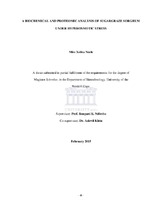| dc.description.abstract | Sugargraze is a moderately drought tolerant sweet sorghum hybrid which is ideal for grazing, winter stand over and pit silage. A major advantage that Sugargraze has over other forages is its very high sugar content which improves feed quality thus increasing palatability and results in significantly reduced feed wastage. This study explored the influence of hyperosmotic stress on plant development, ROS accumulation, antioxidant capacity and the extent of cell death. Heat shock protein (Hsp70) expression immunoblotting assays were used to demonstrate whether the various treatment conditions induced stress within natural physiological parameters for the experimental material. This was coupled with the separation, visualization and identification of abundant proteins in Sugargraze leaves in response to hyperosmotic stress using two-dimensional gel electrophoresis (2-DE) in combination with mass spectrometry (MS). The results showed that hyperosmotic stress significantly influences plant development by reducing plant biomass and increasing the levels of ROS accumulation, proline content and subsequently reducing total chlorophyll content. An over accumulation of ROS in the form of hydrogen peroxide and lipid peroxidation was observed in the stressed plants which was supported by the extent of cell death. Although an increase in antioxidant enzyme activity (in the form of total enzymatic activity or individual isoform activity) in response to hyperosmotic stress was observed, this increase was not sufficient to counter the deleterious effects caused by the stress conditions hence the decrease in plant biomass and increase in cell death. Western blotting analysis of Sugargraze leaf tissues using Hsp70 antibodies showed that hyperosmotic stress induced Hsp70 expression to levels significantly higher than observed for the control plants. A total of thirteen CBB stained spots were selected for mass spectrometric identification, owing to their good resolution and abundance levels, and of these, nine were positively identified. Identified proteins were divided into functional categories including both known and novel/putative stress responsive proteins. Molecular and physiological functions of some of the proteins of interest identified will be subjected to further investigation via bioinformatic and molecular biology approaches. | en_US |

